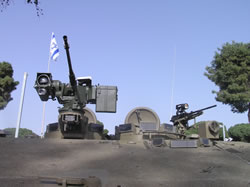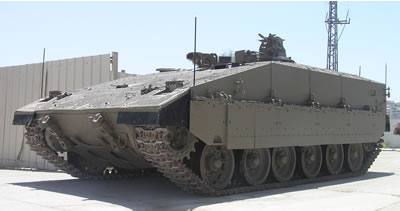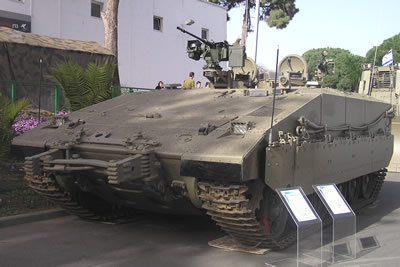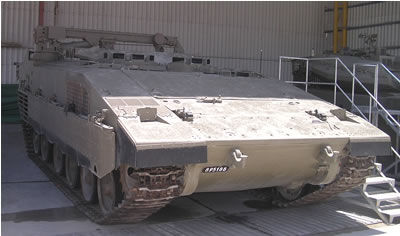Heavyweights are Adapting to LIC
Based on the lessons learned in Lebanon since 1982, the IDF has pursued the development of heavy armored personnel carriers capable of keeping pace with the Merkava tanks while withstanding the same levels of threats. Initially, the IDF converted turretless T-55 and Centurion hulls into heavy APCs. These vehicles were produced in limited numbers and used extensively during the later years of the Israeli – South Lebanese conflict. The IDF has also used these heavy APCs in Gaza, supporting operations around and inside heavily populated areas, and patrolling the border areas around the Gaza strip.
However, according to initial analysis done by the Merkava Program Office (MPO, also called Mantak in Hebrew), the Merkava chassis is far more suitable for this task than the T-55 or Centurion hulls. The Merkava’s forward mounted engine leaves room for a large rear access ramp, and provides a spacious internal configuration for the fighting compartment. The flat roof provides effective observation from closed hatches, and flexible and efficient installations for payloads and remotely controlled weapon stations. The superior base armor and the availability of add-on armor modules provides a Merkava based APC with a protection level unprecedented among contemporary AIFVs.
 As part of the evolution of the Merkava family, this main battle tank chassis will further evolve into a family of heavily armored vehicles, designed for multi-mission operations in high and low-intensity warfare. MPO produced several versions of Merkava based APCs, called Namer (Leopard in Hebrew), utilizing existing chassis of various Merkava models. Two armored infantry carriers were produced fitted with advanced modular Merkava armor and providing accommodation for 12 men: commander, driver, weapon station operator and eight fully equipped troops. The hatch for the driver’s station has been removed and that area provided with additional armor to the top and sides of the vehicle. The underside is reinforced by a belly plate to protect against mines. Remotely controlled weapon stations mounting 7.62mm and M2 heavy machineguns were installed with associated optronics and fire control systems. As in the Merkava Mk 3 LIC, the Namer will have a sniper port located in the rear access door ramp.
As part of the evolution of the Merkava family, this main battle tank chassis will further evolve into a family of heavily armored vehicles, designed for multi-mission operations in high and low-intensity warfare. MPO produced several versions of Merkava based APCs, called Namer (Leopard in Hebrew), utilizing existing chassis of various Merkava models. Two armored infantry carriers were produced fitted with advanced modular Merkava armor and providing accommodation for 12 men: commander, driver, weapon station operator and eight fully equipped troops. The hatch for the driver’s station has been removed and that area provided with additional armor to the top and sides of the vehicle. The underside is reinforced by a belly plate to protect against mines. Remotely controlled weapon stations mounting 7.62mm and M2 heavy machineguns were installed with associated optronics and fire control systems. As in the Merkava Mk 3 LIC, the Namer will have a sniper port located in the rear access door ramp.
The new vehicles will enable effective operation in “buttoned up” conditions over extended durations, offering spacious interiors and rapid access and dismounting of troops. For medical evacuation under fire, every Namer will be fitted for collapsible stretcher carriage to facilitate rapid and efficient battlefield MEDEVAC operations. Safety equipment includes blast-absorbing seats for the crew and an internal fire suppression system. Another version with an elevated, remotely controlled mount carrying a 30mm gun has also been tested.
Other configurations include an armored recovery vehicle, and a company support vehicle, fitted with all tools required for the combat maintenance and support team. Future configurations could include a multi-purpose missile launcher enabling engagement of targets beyond line of sight.
According to Amir Nir, IDF Merkava Project Manager (MPO), the Namer could enter production by 2010, to be followed as early as 2015 with a new platform based on an evolutionary Merkava chassis. General Nir told Defense Update that he foresees a versatile ground platform that would be lighter than the current Merkava, weighing around 35-40 tons, but retaining the Merkava’s excellent protection from all types of threats including kinetic projectiles, belly charges, shaped charges and IEDs. The weight saving will be achieved primarily through replacement of the turret with a remotely controlled, integrated gun and missile station. The use of active protection armor instead of conventional armor could result in further weight reductions. The vehicle could also deploy unmanned systems and missiles to allow Beyond Line Of Sight (BLOS) as well as direct fire engagements.
Additional parts of this article:
- Merkava Mk 4 – IDF Continues Merkava Mk 4 Evolution
- Merkava Mk 4 – Firepower Improvements
- Merkava Mk 4 – Optronics and BMS
- Merkava Mk 4 – A Growing Family of AFVs
- Merkava Mk 4 – Promising Export Potential
Read more:























